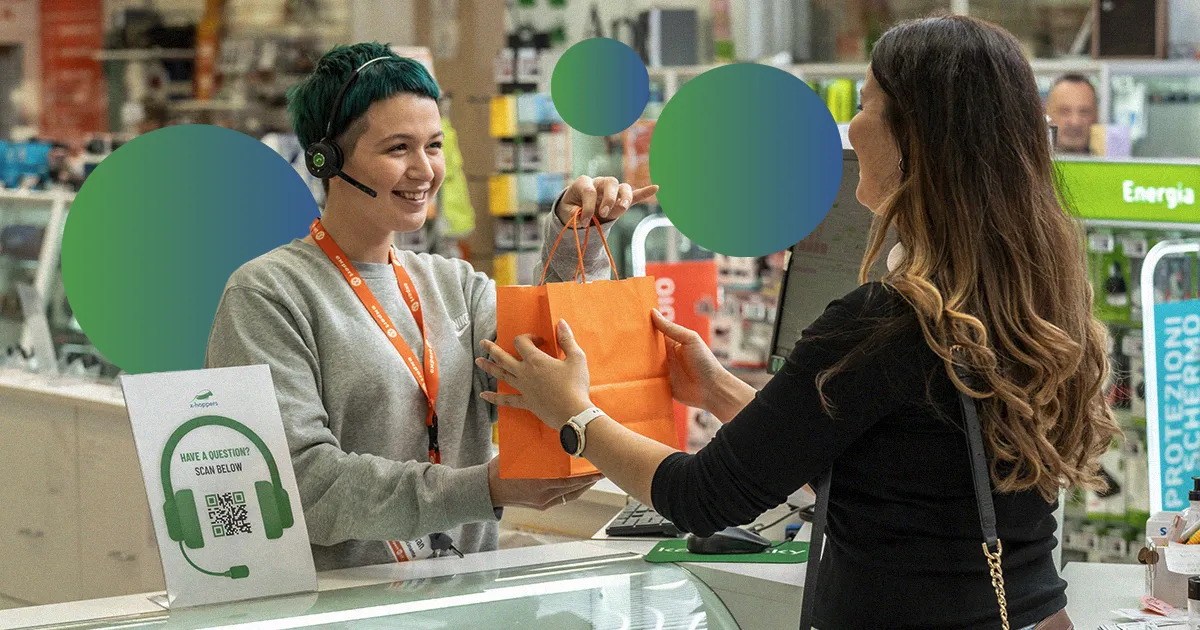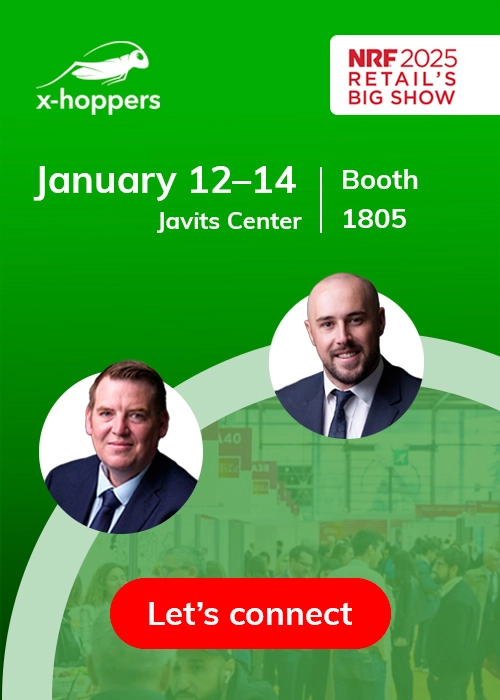
Driving In-Store Sales: Eight Retail Conversion Tips
Capturing consumer interest — and money — is a continuously evolving challenge in retail. Right now with inflation squeezing wallets, the wide adoption of hybrid work and more customers shopping online, footfall has fallen across physical stores. But all is not lost, because the customers coming into your store are there for a purpose. To entice them to spend in your brick-and-mortar stores all you need to do is implement some of our retail conversion tips and you’ll see them go from window shoppers to super fans in no time.
What Is Conversion in Retail Stores?
Conversion, or more precisely the conversion rate, is the percentage of people who enter a store that actually purchase a product or service.
How to calculate conversion in retail
The equation to find your conversion rate is quite straightforward. You simply divide the number of transactions by the number of visitors and multiply the number by 100.
#transactions / #visitors x 100 = conversion rate
Most stores will have cameras or scanners that count the number of people that enter the store. In some instances, the technology is clever enough to only count adults instead of children, providing a number that more accurately reflects visitors with spending power.
Transactions are much easier to measure as any POS system worth its salt will provide you with clear data on the number of transactions a store produces by day, week, month, quarter or year. Just make sure that both metrics cover the same time period to ensure you get an accurate measurement.
Why Is Conversion in Retail Stores an Important Metric?
To stay open a store needs to make money. Identifying your conversion rate is one step that can help you effectively troubleshoot your store’s performance and decide what actions to take if you need to improve sales. For example, if you have a high conversion rate but you’re still not meeting targets, then you need to drive more foot traffic to your store through events and external marketing campaigns. Or, if you’re already doing that or you’re finding it’s unsuccessful, then you might need to look at other costs, like shrink, that could be eating into your profits.
But if your conversion rate is low, then you already have potential customers in your shop, you just need to uncover what’s holding them back from spending. Luckily, by following a few retail conversion tips you can remove some of the barriers that stop visitors from becoming customers.
How to Increase the Conversion Rate: Our Top Retail Conversion Tips
Visitors come to your store with a diverse set of interests and needs. As a result, no one trick will instantly improve your conversion rate. Instead, there are a few strategies that address different issues, challenges and types of customers, including:
- Base staff levels on visitors, not past sales
- Improve staff training
- Offer warranties and returns
- Test and analyze your store layout
- Ensure shelves are stocked, priced and organized
- Embrace phygital experiences
- Provide free Wi‑Fi
- Reduce friction at checkouts
Before implementing any of the retail conversion tips above, make sure you know your target audience well enough to avoid changing what already works and accidentally undermining your unique brand image.
Base staff levels on visitors, not past sales
Getting staffing right is tricky. You have to strike a delicate balance to ensure you’re not overstaffed during quiet times or understaffed during busy periods. Often, the most common way to predict peak periods is by analyzing sales data from previous years. However, that will only help you replicate past successes. If you want to increase your sales, you need to identify the opportunities you lost. So instead, make sure you staff based on footfall and visitor numbers, not sales. That way you’re more likely to have enough employees on the ground to serve customers, resulting in a higher conversion rate and if you get it right, a higher average transaction value (ATV).
Of course, people are hard to predict. So in addition to careful staffing, consider investing in a retail headset system, such as x‑hoppers, which allows staff members to quickly collaborate and problem solve as well as receive notifications from systems and customers, making it easier for them to switch between tasks and increase their availability on the shop floor.
Train your staff
Your employees set the tone for your entire store — and in many cases, your brand. If they can’t answer customer questions or constantly push people to the website, customers will skip the trip to your store and shop elsewhere. As a result, investing in training that covers not only procedures but also product knowledge is vital to selling customers the right item the first time and building customer loyalty.
Of course, depending on what you sell, it’s unlikely that you can train every single store associate on every product. That’s why in addition to traditional training sessions and online learning modules it’s worth giving store associates instant access to product information from anywhere on the shop floor. Once again, x‑hoppers is perfect for this as in addition to connecting employees, its AI Assistant can connect to your database, allowing store associates to quickly ask natural questions via the headset and receive answers generated by the AI. What this means is that store associates don’t have to “translate” customer questions into narrowly defined queries, instead, the AI Assistant processes natural language and can even compare and contrast products, helping staff members give customers fact-based advice.
So if you’re focused on how to increase the conversion rate in your retail store, make sure you prioritize training your employees and giving them access to knowledge on demand. Because confident, knowledgeable staff members are not only more equipped to answer customer queries, they also have the influence to upsell and cross-sell, improving not only your conversion rate but your ATV as well.
Offer warranties and clear return policies
One of the often overlooked retail conversion tips is quite simple — offer warranties and returns. Let’s take a mattress for example: It’s a purchase that customers plan to buy every eight to ten years. Before they spend hundreds or thousands on it, they want to make sure it’s comfortable and going to last more than a few months. However, for the average consumer, it’s hard to judge the quality of a mattress just by trying it out in the showroom. That’s why mattresses that come with a five, eight or even ten-year warranty can make the difference between a customer making the purchase or leaving the store to “think it over”.
The same can be said for a clear returns policy. Customers are more likely to buy a product if they know that they can return it if it doesn’t fit, isn’t the right color or if they change their mind. Just be mindful to not make the policy too open or you risk undermining the gains made in sales with higher returns costs. Manage customer expectations by setting deadlines for returns, requiring proof of purchase and, if necessary, requiring products to be in their original packaging or at least near-new condition.
Test and analyze your store layout
A lot of effort goes into planning a store layout, but you should never feel it is etched in stone. Gather data by creating customer flows to identify the “hot spots” in your store that naturally catch your customer’s eye. Once you’ve done that, choose the products to place in the hot spots carefully, prioritizing ones that are either new, seasonal or in high demand to encourage even casual visitors to add an item to their basket.
If you notice that your current layout is creating a lot of “cold spots” don’t be afraid to adjust the walls and fixtures in your store in addition to relocating products. If one display is blocking the view of others or if it’s overwhelming having too many shelves near the entrance, move them. Make sure that you test and analyze whatever changes you make to see what is working and what isn’t.
Even small changes such as putting add-ons next to big-ticket items or rearranging impulse buys near checkouts need to be tracked and documented. Because even if the changes you make work in the short term, customer interests and behaviors change, so you need to stay alert and curious. Looking beyond sales data by collecting frequently asked questions is a good way to identify where there’s additional room for improvement. For example, with x‑hoppers, you can view reports that identify common phrases spoken over the headset system as well as read daily recaps, giving you valuable insight on common recurring questions and problems. That way, if you see that customers are always asking where the charging cables are, you can relocate them to a more visible or logical spot, increasing sales while simultaneously freeing up your store associate to serve other customers.
Ensure shelves are stocked, priced and organized
People can’t buy products if they aren’t there. More often than not, potential customers have come into the store specifically to take away a product that day. So if it’s not in its designated spot, the sale is lost. The same can be said for items buried behind other products on a shelf or missing pricing information. Customers aren’t going to search your whole store for a product or a price label. At best, they will ask for a member of staff for help. But if your store associates are busy or the customer is in a hurry, they will just leave.
That’s why one of our most important retail conversion tips requires you to investigate why shelves are empty, messy or missing pricing information to get to the root of the problem. It could be an issue with stock management and you need to invest in improving your ordering and restocking procedures. It could also be an issue of theft or one of the other causes of shrink we’ve outlined in our previous post. In either case, ensuring your staff members can quickly collaborate over secure, wireless headsets allows them to efficiently keep up with tasks such as restocking and pricing and still be just a call away if their colleagues need support.
Of course, even the best-laid plans can be scuppered by supply chain issues or the occasional run on a specific product. So if you have a strong omnichannel strategy, consider adding QR codes on your pricing solution that link to product pages, allowing customers to order them for home delivery while they’re still in the store, or request updates on supply issues. With the right communication system, you can even turn QR codes into smart call points, allowing customers to connect with knowledgeable staff on- or off-site. Just ensure that low product availability is an exception and not a rule. Otherwise, you’ll just push your customers away from the store to the website, or worse, a competitor.
Embrace phygital experiences
Now the last thing we want to suggest is that your store and website are locked in combat. We all know that’s not the case. And with services such as buy online pick up in‑store and in‑store returns for online purchases, there are quite a few cases where a robust omnichannel strategy can drive online customers to your store.
The trick is getting them to spend in‑store and return. You can do this subtly by placing the collection point away from the front door and further in the store, causing customers to pass by potential impulse purchases. However, if you’d rather emphasize convenience and keep the collection point close to the entrance, encourage your staff members to be friendly, be helpful and ask key questions such as “is there anything else you need” or, if it’s a complicated product, “just to check, do you know that this item needs…” and suggest an add-on product. These short questions may open sales opportunities and also greatly improve the customer experience because there’s nothing worse than getting home just to discover that you forgot curtain brackets for your curtain pole.
Just make sure that you’re set up to accept payment at the desk and that you have a quick way to request products. Otherwise, you risk ruining the convenience and souring the customer on considering in‑store purchases in the future, hurting conversion in your retail stores.
Provide free Wi‑Fi
Yes, it’s true, many customers have comprehensive mobile data plans, but not everyone does and often signal strength can vary depending around the store or, depending on the building materials, work in the store at all. Providing free Wi‑Fi helps you ensure that your customers can access your app or website while in‑store, supporting the omnichannel experience. It also can help you convert in‑store international visitors who may be restricting their data use due to high charges. It’s just a small thing you can do for your customers that reinforces trust, reduces friction and helps you increase both in‑store and online conversions. And speaking of friction…
Reduce friction at checkouts
Customers don’t like to wait, and they also relish choice. As a result, only offering a handful of manned checkouts inevitably leads to long lines and abandoned baskets. To avoid this, make sure you offer multiple payment options, including cash, card, digital wallets and, if possible, buy now, pay later services.
Self-checkouts are also helpful, as they allow you to serve more customers with fewer staff members. Just keep in mind that customers still need staff support to use the machines because of bag reading errors, age verification prompts or scanning issues. There’s also the issue of inadvertent or overt theft, due to customers not scanning all their items. As a result, it’s worth looking into a headset solution, such as x‑hoppers, that will integrate with your POS system and send detailed notifications directly to your store associates. That way they can respond quickly to issues while also keeping their attention on any suspicious activity in the area.
In addition to accepting different types of payment and installing self-checkouts, you can provide customers with smart carts and scan-and-go technology or equip store associates with mobile payment devices, allowing customers to skip the line altogether by paying anywhere on the shop floor. Although be warned, while some of this new technology is exciting, carefully consider your customer base and brand positioning when deciding what kind of POS system to use. There are customers that still prefer a checkout lane with a cashier, so try different options and offer as many choices as make sense for your business.
Key Takeaways
Hopefully, this article has given you a clear understanding of how to calculate conversion in retail, why it’s important and the actions you can take to improve your in‑store conversion rate.
In short, regardless of which retail conversion tips you decide to implement, we suggest you support your staff members with the right tools, such as x‑hoppers’s retail headset system, so they can manage any changes as a team and work together to serve customers. Even on its own, this type of facilitated teamwork can go a long way in increasing customer satisfaction, and by extension, spending.
But whatever you do, make sure that you analyze the effectiveness of each change and its impact on individual product sales, the overall conversion rate and even ATV. Don’t assume things are working, make sure that you can prove it. And if you find something that works, iterate it and share it — apply it to other products and roll it out to other stores.
Because there’s no one-size-fits-all approach that will automatically transform your conversion rate, so approach it with curiosity, patience and persistence and you’ll soon see results not only in conversion but in repeat sales from satisfied and loyal customers.


